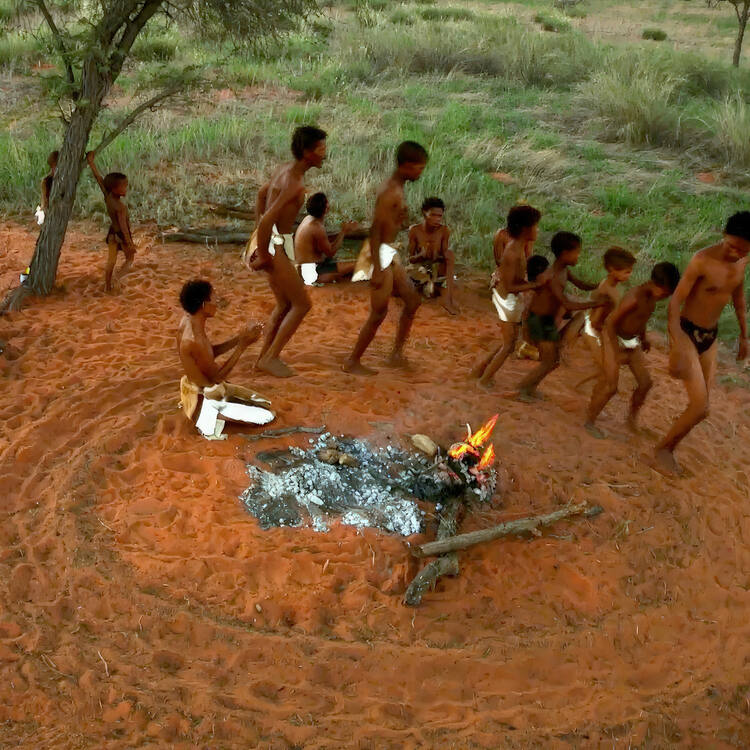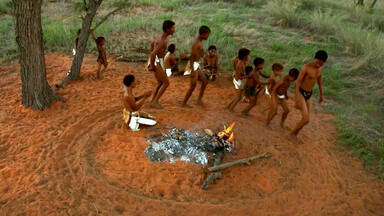ǂKhomani Cultural Landscape
ǂKhomani Cultural Landscape
The ǂKhomani Cultural Landscape is located at the border with Botswana and Namibia in the northern part of the country, coinciding with the Kalahari Gemsbok National Park (KGNP). The large expanse of sand contains evidence of human occupation from the Stone Age to the present and is associated with the culture of the formerly nomadic ǂKhomani San people and the strategies that allowed them to adapt to harsh desert conditions. They developed a specific ethnobotanical knowledge, cultural practices and a worldview related to the geographical features of their environment. The ǂKhomani Cultural Landscape bears testimony to the way of life that prevailed in the region and shaped the site over thousands of years.
Description is available under license CC-BY-SA IGO 3.0
Paysage culturel des ǂKhomani
Le paysage culturel des ǂKhomani est situé à la frontière avec le Botswana et la Namibie, dans la partie septentrionale du pays, coïncidant avec le parc national Kalahari Gemsbok. Cette grande étendue de sable contient des traces d'occupation humaine depuis l'Âge de la pierre jusqu'à nos jours, et est associée à la culture des ǂKhomani San. Ce peuple, autrefois nomade, élabora des stratégies de subsistance pour faire face aux dures conditions de vie du désert. Il a développé des connaissances spécifiques en ethnobotanique ainsi que des pratiques culturelles et une vision du monde liées aux caractéristiques géographiques de son environnement. Le paysage culturel des ǂKhomani reflète le mode de vie qui fut prédominant dans la région et façonna le site durant des milliers d’années.
Description is available under license CC-BY-SA IGO 3.0
منظر الخوماني الثقافي
يقع هذا المنظر الثقافي على الحدود مع بوتسوانا وناميبيا في الجزء الشمالي من البلد. ويضم منطقة شاسعة في منتزه كاهاري جيمسبوك القومي. وتظهر هذه المنطقة الشاسعة من الكثبان الرمليّة آثار الاستيطان البشري منذ العصر الحجري حتى يومنا هذا، وترتبط بثقافة خوماني سان. ووضع هذا الشعب ذو الأصول البدويّة استراتيجيّات متعلّقة بسبل المعيشة وكسب الرزق لمواجهة الظروف البيئيّة القاسية. كما عملوا على تطوير معارف خاصة حول أصول النباتات بالإضافة إلى ممارسات ثقافيّة ورؤية للعالم بناء على الخصائص الجغرافيّة. وتجدر الإشارة إلى أنّ منظر الخوماني الثقافي يجسّد أسلوب الحياة الذي كان سائداً في المنطقة على مرّ آلاف السنين والذي ساهم في تشكيل هذا الموقع.
source: UNESCO/CPE
Description is available under license CC-BY-SA IGO 3.0
Paisaje cultural de los ǂkhomani
source: UNESCO/CPE
Description is available under license CC-BY-SA IGO 3.0
ǂKhomani Cultuurlandschap
Source: unesco.nl
Outstanding Universal Value
Brief synthesis
The ǂKhomani Cultural Landscape is located at the border with Botswana and Namibia in the northern part of the country. The property comprises a vast area that coincides with the Kalahari Gemsbok National Park (KGNP). The large expanse of sand dunes forms a landscape which contains tangible evidence of human occupation from the Stone Age to the present and is associated with the culture of the ǂKhomani and related San people. The landscape includes landmarks of the history, migration, livelihoods, memory and resources of the ǂKhomani and related San people and other communities, past and present, and attests to their adaptive responses and interaction to survive in a desert environment. The ǂKhomani and related San people are formerly nomadic populations and among the last indigenous communities in South Africa. They developed subsistence strategies to cope with the extreme conditions of the environment and developed a specific ethnobotanical and veld knowledge as well as cultural practices and a worldview where geographical features embody symbolic links between humans, wildlife and the land.
The ǂKhomani are actively reclaiming their knowledge, practices and traditions, bringing back to life a rich associative landscape, thanks also to the survival of the last speakers of the !Ui-Taa languages in the ǂKhomani community. The ǂKhomani Cultural Landscape reflects the ethos of the ǂKhomani and related San people of living softly on the land and seeing themselves as part of nature, in a landscape where there is a respectful relationship between humans, plants and animals, links them to this land in a unique way that epitomises sustainability.
Criterion (v): The ǂKhomani Cultural Landscape is uniquely expressive of the hunting and gathering way of life practised by the ancestors of all modern human beings; so are the simple, yet highly sophisticated technologies which they used to exploit scarce resources such as water, find plant foods in an extremely hostile environment, and deal with natural phenomena such as drought and predators.
Criterion (vi): The ǂKhomani Cultural Landscape reflects and is associated with the ethnobotanical knowledge and memories embedded in the !Ui-Taa languages still spoken by a few people in the ǂKhomani community, illustrating a virtually extinct way of life and beliefs.
Integrity
As an associated landscape, the ǂKhomani Cultural Landscape is a vast area on the South African side of the Kgalagadi Transfrontier Park (KTP), which is large enough to accommodate a reasonably complete representation of the landscape values, features and processes which convey the special way in which the people were linked with the land. It is also sufficiently large to accommodate the tangible elements of landscape and culture, such as the wide and open dunes, examples of Bushman architecture and the ‘lightness’ of being in the desert. The archaeological sites in the dunes remain largely intact and the names of important places have been recorded and mapped. More vulnerable are the languages spoken by the ‡Khomani, which are being promoted through joint activities between the community and supportive Non-Governmental Organisations (NGOs). In the areas outside the property there are a number of settlements and sites that play a role in the cultural memory of the ǂKhomani and its diaspora.
Residential development, commercial farming and the state-run National Park have changed the cultural landscape over the past century, resulting in severe disruptions of the living traditions of the ǂKhomani San and related families. However, links to the landscape persist and are being re-established since the land claim success. The South African San Institute (SASI) and other institutions have been working with the ǂKhomani to record knowledge systems, language, and oral history through stories. The Imbewu bush camp is situated deep in the dunes of the !Ae!Hai Kalahari Heritage Park which lies in the southern part of the KGNP. The Imbewu camp belongs to the ǂKhomani-Mier community. Here the tradition of ‘veldskool’ (meaning ‘field or bush school’) is regularly practised, affording young people from the community the opportunity to learn from the elders about the plants, animals, and ecological interrelationships as well as the spiritual world.
The property’s Outstanding Universal Value is enhanced through its association with the wider territory over which the ǂKhomani families migrated on a seasonal basis, and shared with the !Kung in the south of Botswana.
Authenticity
The ǂKhomani Cultural Landscape reflects the cultural links that a core group of ǂKhomani San people retained with their land. These associations are expressed by tangible and intangible attributes, the former mainly represented by archaeological testimonies, the latter including the ethnobotanical and ‘veld’ knowledge, and the persistence of linguistic memory, supported now by NGOs and academics who are documenting language and culture in accessible ways. The ǂKhomani have regained symbolic and cultural rights to that land, including resource use and traditional hunting rights in a large part of the park. This helps to ensure that the ǂKhomani’s cultural renaissance and ensures that it would not become a “museum culture”. An important element of this is the wider ecological and ultimately even social connectivity made possible by the KTP, including the revival of old social networks to communities in Botswana. The ǂKhomani will not revert to a “genuine” transhumant hunter-gatherer existence. Yet, the continued existence of Bush craft and tracking skills, the persistence of cultural practices like dancing, healing, singing and storytelling contribute to maintain the association with the property as well as the indefinable spirit of “Boesman wees” (‘being a Bushman’). Authenticity is further enhanced through the wider context of the ǂKhomani Cultural Landscape as part of the broader |Xam and ǂKhomani Heartland Cultural Landscape.
Protection and management requirements
The ǂKhomani Cultural Landscape falls wholly inside the Kalahari Gemsbok National Park (KGNP), of which it forms the overriding cultural component and it is also included in the Kgalagadi Transfrontier Park (KTP). Both Parks provide formal statutory protection status as protected areas. The relevant environmental protection laws are the National Environmental Management Act, 1998 (NEMA); National Environmental Management: Protected Areas Act n. 57/2003 (NEMPAA) and National Environmental Management: Biodiversity Act. All archaeological sites within the property are protected under the National Heritage Resource Act n. 25/1999 (NHRA).
On the Botswana side, the property is bordered entirely by the Gemsbok National Park, which also forms the Botswana component of the KTP. Beyond the borders of the KGNP on the South African side there is communal land of the Mier community and private farms. It is envisaged that any development therein would require consultation to avoid negative impact on the Outstanding Universal Value (OUV) of the property.
Further protection is granted by the planning system which is regulated by an array of laws and instruments. Local and district municipalities prepare an Integrated Development Plan (IDP) – a strategic planning instrument which guides and informs all planning, budgeting, management and decision-making in a municipality and is reviewed annually (Municipal System Act (2000)). The 2016/17 IDP for the ZF Mgcawu District Municipality is in place. The Spatial Planning and Land Use Management Act, 2013 (SPLUMA) provides for the national, provincial and local spheres of government to prepare Spatial Development Frameworks (SDFs) with a 5-year lifecycle - to represent the spatial development vision and to guide planning and development decisions across all sectors of government.
The overarching management framework of the Park provides a well-entrenched set of legal mechanisms relating to heritage, conservation and environmental protection that applies to all National Parks in South Africa. Reviewing mechanisms of the Management instruments of the KGNP allow for updating and integrating provisions and measures to ensure effective safeguard of both tangible and intangible heritage in compliance with the 2003 UNESCO Convention for the Safeguarding of Intangible Cultural Heritage to which South Africa is a signatory. The protection of cultural heritage is further dealt with in the Integrated Development Plan of the KTP and the !Ae!Hai Kalahari Heritage Park management plans (hereafter simply referred as the ‘Heritage Park’), which falls wholly inside the KGNP. The KGNP, acting in collaboration with the Joint Management Board of the Heritage Park and a number of NGOs, provides the necessary institutional capacity needed for the protection of the property. The sustenance in the long term of the cultural associations of the ǂKhomani San with the property and of their culture relies on improved capacity of the local communities, e.g. through the ǂKhomani San Communal Property Association (CPA), to increase their involvement in all aspects of management, conservation and safeguarding of the property and on ensuring that benefits produced by the World Heritage property improve the social and economic development of the ǂKhomani as a community, in accordance with the Johannesburg Declaration on World Heritage in Africa and Sustainable Development of 2002, and the UNESCO Action Plan 2012-2017 for the Africa Region. The property management is guided by various management plans: the management plans of the Heritage Park and the KGNP will guide appropriate tourism development within the property. To ensure effective protection and sustenance of the OUV of the property, the management plan of the KGNP shall include adequate provisions for the protection of the OUV and the integrity and authenticity of the property and prevent any potential negative impacts by development, including tourism. The use of Environmental Impact Assessment (EIA) processes, as well as stringent Heritage Impact Assessment (HIA) criteria, under South African law, shall ensure that development, including tourism related facilities and amenities within, and adjacent to, the property, will not have negative impacts on the OUV of the property.


